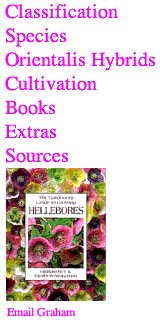

Sometimes only old seed is available, and seed from large commercial seed companies which arrives six months after harvest is, in the case of hellebores, classified as ‘old’. It is a waste to treat these seeds in the same way as fresh seed.
It is a mistaken belief that hellebore seeds require a period of frost before they will germinate. In truth, what they need is a warm and moist period, followed by declining temperatures - after which germination takes place. A long period of cold is not required. The warm, moist period is provided by sowing the seed in summer and keeping it from drying out; then as temperatures reduce naturally germination is initiated.
If seed is sown in the winter, it receives the right treatments - but in the wrong order, cold first and warmth later in the spring. So with old seed there are two ways of giving the seeds the right sequence of conditions. The first is simply to keep the seed, dry but refrigerated, until summer and sow it at the same time as fresh seed. This can sometimes give good germination.
Alternatively, sow the seed in winter as described above, not later than early January, but instead of standing the pots in a cold frame put them in a propagator with the thermostat set at 60F/15C, in a warm greenhouse, or on a bedroom windowsill - anywhere which will keep the seeds warm. Then after six weeks move the pots outside where, after a period of cold weather, the seeds should germinate.
Germination of fresh seed can be close to 100%; expect the germination of old seed, sown in the way I describe to be about 50%. Germination of old seed sown outside in winter is often minimal and sporadic.